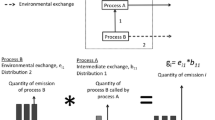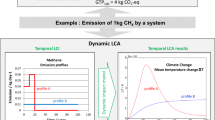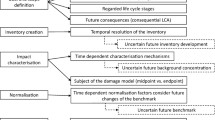Abstract
Purpose
Life cycle assessment is usually an assessment tool, which only considers steady-state processes, as the temporal and spatial dimensions are lost during the life cycle inventory (LCI). This approach therefore reduces the environmental relevance of certain results, as it has been underlined in the case of climate change studies. Given that the development of dynamic impact methods is based on dynamic inventory data, it seems essential to develop a general methodology to achieve a temporal LCI.
Methods
This study presents a method for selecting the steps, within the whole process network, for which dynamics need to be considered while others can be approximated by steady-state representation. The selection procedure is based on the sensitivity of the impacts on the variation of environmental and economic flows. Once these flows have been identified, their respective timescales are compared to the inherent timescales of the impact categories affected by the flows. The timescales of the impacts are divided into three categories (days, months, years) based on a literature review of the ReCiPe method. The introduction of a temporal dynamic depends on the relationship between the timescale of the environmental and economic flows on the one hand and that of the concerned impact on the other hand.
Results and discussion
This approach is illustrated by the life cycle assessment of palm methyl ester and ethanol from sugarcane. In both cases, the introduction of a temporal dynamic is limited to a small proportion of the total number of flows: 0.1 % in the sugarcane ethanol production and 0.01 % in the palm methyl ester production. Future developments of time integration in the LCI and in the life cycle impact assessment (LCIA) are also discussed in order to deal with the need of characterization functions and the recurrent problem of waiting times.
Conclusions
This work provides a method to select specific flows where the introduction of temporal dynamics is most relevant. It is based on sensitivity analyses and on the relationship between the timescales of the flows and the timescale of the involved impact. The time-distributed LCI generated by using this approach could then be coupled with a dynamic LCIA proposed in the literature.



Similar content being viewed by others
References
Brandão M, Levasseur A, Kirschbaum MUF et al (2013) Key issues and options in accounting for carbon sequestration and temporary storage in life cycle assessment and carbon footprinting. Int J Life Cycle Assess 18(1):230–240
Cucurachi S, Heijungs R, Ohlau K (2012) Towards a general framework for including noise impacts in LCA. Int J Life Cycle Assess 17(4):471–487
Cherubini F, Peters GP, Berntsen T et al (2011) CO2 emissions from biomass combustion for bioenergy: atmospheric decay and contribution to global warming. GCB Bioenergy 3(5):413–426
Crouzet P, Leonard J, Nixon S, Rees Y, Parr W, Laffon L, Bogestrand J, Kristensen P, Lallana C, Izzo G, Bokn T, Bak J, Lack TJ, Thyssen N (ed) (1999) Nutrients in European ecosystems. European Environment Agency, Copenhagen, Environmental assessment report, no 4
Field F, Kirchain R, Clark J (2000) Life-cycle assessment and temporal distributions of emissions: developing a fleet-based analysis. J Ind Ecol 4(2):71–91
Goedkoop M, Spriensma R (2000) The Eco-indicator 99: a damage oriented method for life cycle impact assessment. PRé Consultants, Amersfoort, Netherlands
Goedkoop M, Heijungs R, Huijbreghts, De Schryver A, Struijs J, van Zelm R (2009) ReCiPe 2008. A life cycle impact assessment method which comprises harmonised category indicators at the midpoint and the endpoint level
Guinée JB, Gorrée M, Heijungs R, Huppes G, Kleijn R, de Oning A, van Oers L, Sleeswijk AW, Suh S, Udo de Haes HA, de Bruin H, van Duin R, Huijbregts MAJ (2002) Handbook on life cycle assessment. Operational guide to the ISO Standards. Centre of Environmental Science, Leiden University (CML)
Harville D (1997) Matrix algebra from a statistician's perspective. Springer, New York
Hauschild M, Potting J (2005) Spatial differentiation in life cycle impact assessment—the EDIP2003 methodology. Environmental news no. 80. The Danish Ministry of the Environment, Environmental Protection Agency, Copenhagen
Hauschild M (2006) Spatial differentiation in life cycle impact assessment: a decade of method development to increase the environmental realism of LCIA. Int J Life Cycle Assess 11(S1):11–13
Heijungs R, Suh S (2002) The computational structure of life cycle assessment. Kluwer, Dordrecht
Heijungs R (2010) Sensitivity coefficients for matrix-based LCA. Int J Life Cycle Assess 15(5):511–520
Hellweg S, Hofstetter B, Hungerbühler K (2003) Discounting and the environment should current impacts be weighted differently than impacts harming future generations? Int J Life Cycle Assess 8(1):8–18
Hellweg S, Hofstetter B, Hungerbühler K (2005) Time-dependent life-cycle assessment of slag landfills with the help of scenario analysis: the example of Cd and Cu. J Clean Prod 13(3):301–320
Huijbregts MAJ (1998) Application of uncertainty and variability in LCA. Int J Life Cycle Assess 3(5):273–280
IPCC (2000) Land use, land-use change and forestry. IPCC special report. Cambridge University Press, Cambridge. http://www.grida.no/climate/ipcc/land_use/157.htm
IPCC (2007) IPCC fourth assessment report, Working Group 1, report “The Physical Science Basis”. http://www.ipcc.ch/publications_and_data/ar4/wg1/en/contents.html. Accessed Apr 2012
Lebailly F, Levasseur A, Samson R et al (2013) Considering temporal variability for the characterization of metals aquatic ecotoxicity impacts in LCA. Proc. of the 23rd SETAC Europe, 12–16 May 2013, Glasgow, Scotland
Levasseur A, Lesage P, Margni M et al (2010) Considering time in LCA: dynamic LCA and its application to global warming impact assessments. Environ Sci Technol 44(8):3169–3174
Levasseur A, Brandão M, Lesage P et al (2011) Valuing temporary carbon storage. Nat Clim Chang 2(1):6–8
Levasseur A, Lesage P, Margni M et al (2012) Assessing temporary carbon sequestration and storage projects through land use, land-use change and forestry: comparison of dynamic life cycle assessment with ton-year approaches. Clim Chang 115(3–4):759–776
Manneh R, Margni M, Deschênes L (2012) Evaluating the relevance of seasonal differentiation of human health intake fractions in life cycle assessment. Integr Environ Assess Manag 8(4):749–759
McKone TE, Nazaroff WW, Berck P et al (2011) Grand challenges for life-cycle assessment of biofuels. Environ Sci Technol 45(5):1751–1756
Owens JW (1997) Life-cycle assessment in relation to risk assessment: an evolving perspective. Risk Anal 17(3):359–365
Pesonen H, Ekvall T, Fleischer G, Huppes G, Jahn C, Klos ZS, Rebitzer G, Sonnemann GW, Tintinelli A, Weidema BP (2000) Framework for scenario development in LCA. Int J Life Cycle Assess 5:21–30
Pfister S, Koehler A, Hellweg S (2009) Assessing the environmental impacts of freshwater consumption in LCA. Environ Sci Technol 43(11):4098–4104
Reap J, Roman F, Duncan S, Bras B (2008) A survey of unresolved problems in life cycle assessment. Int J Life Cycle Assess 13(4):290–300
Schwietzke S, Griffin WM, Matthews HS (2011) Relevance of emissions timing in biofuel greenhouse gases and climate impacts. Environ Sci Technol 45(19):8197–8203
Seppälä J, Posch M, Johansson M, Hettelingh J (2006) Country-dependent characterisation factors for acidification and terrestrial eutrophication based on accumulated exceedance as an impact category indicator. Int J Life Cycle Assess 11(6):403–416
Shah VP, Ries RJ (2009) A characterization model with spatial and temporal resolution for life cycle impact assessment of photochemical precursors in the United States. Int J Life Cycle Assess 14(4):313–327
Stasinopoulos P, Compston P, Newell B, Jones HM (2011) A system dynamics approach in LCA to account for temporal effects—a consequential energy LCI of car body-in-whites. Int J Life Cycle Assess 17(2):199–207
Thompson M, Ellis R, Wildavsky A (1990) Cultural theory. Westview Print, Boulder
Udo deHaes HA, Finnveden G, Goedkoop M, Hauschild M, Hertwich EG, Hofstetter P, Jolliet O, Klopffer W, Krewitt W, Lindeijer E, Mueller- Wenk R, Olsen SI, Pennington DW, Potting J, Steen B (eds) (2002) Life-cycle impact assessment: striving towards best practice. Society of Environmental Toxicology and Chemistry (SETAC), Pensacola
Udo de Haes HA, Heijungs R, Suh S, Huppes G (2004) Three strategies to overcome the limitations of life-cycle assessment. J Ind Ecol 8(3):19–32
Udo de Haes HA (2006) How to approach land use in LCIA or, how to avoid the Cinderella effect? Int J Life Cycle Assess 11(4):219–221
Wuebbles DJ (1983) Chlorocarbon emission scenarios: potential impact on stratospheric ozone. J Geophys Res 88(C2):1433–1443
van Zelm R, Huijbregts MAJ, van Jaarsveld HA, Reinds GJ, de Zwart D, Struijs J, van de Meent D (2007) Time horizon dependent characterization factors for acidification in life-cycle assessment based on forest plant species occurrence in Europe. Environ Sci Technol 41(3):922–927
Acknowledgments
This paper presents research results supported by the ANR-08-BIOE-11 Symbiose project. P. Collet, A. Hélias and L. Lardon are members of the ELSA research group (Environmental Life Cycle and Sustainability Assessment, http://www.elsa-lca.org/); they thank all the other members of ELSA for their advice.
Author information
Authors and Affiliations
Corresponding author
Additional information
Responsible editor: Mary Ann Curran
Rights and permissions
About this article
Cite this article
Collet, P., Lardon, L., Steyer, JP. et al. How to take time into account in the inventory step: a selective introduction based on sensitivity analysis. Int J Life Cycle Assess 19, 320–330 (2014). https://doi.org/10.1007/s11367-013-0636-7
Received:
Accepted:
Published:
Issue Date:
DOI: https://doi.org/10.1007/s11367-013-0636-7




